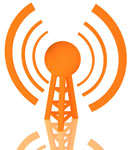
Why can Wi-Fi be so great in some places but so awful in others? (Ahem... Hotels.) Time to stop imagining Wi-Fi as magic and instead think of it just as a means of taking one connection and sharing it among many people without wires.
If you take a ho-hum connection and share it with 10 people, it becomes a bad connection. On the other hand, if you take a great connection and share it with those same 10 people, they will be very happy surfers. As Benoit Felten recently told us, the best wireless networks have been built in cities with the best wired infrastructure.
Wi-Fi still has hiccups but they are well worth it for convenience, mobility, and ubiquity. In a recent GigaOm article, Stacey Higgenbotham detailed additional reasons that not all Wi-fi is created equal.
Higgenbotham lays out the limitations of Wi-fi and breaks down the technology's touchiness into four main factors. She addresses the issue specifically for travelers. From the article:
Backhaul: For most Wi-Fi is their access to the internet, but it’s actually just a radio technology that moves information over the air.
…
Density:…the more people you add to a network — even if those people are just checking their Facebook page — the worse the network will perform.
…
Movement: Wi-Fi connectivity is designed for fixed access, meaning the radios stay put...when you try to jump from hot spot to hot spot problems occur.
...
Device: Newer phones and tablets are supporting a dual-mode Wi-Fi radio, which means they can hop from the 2.4 Ghz band to the 5 GHz band….now with phones like the latest iPhone that have dual-band support, you may hop to another band only to find a bunch of other users.
Higgenbotham doesn't have the answers on how to improve service, but she offers practical advice:
Given these constraints, it hopefully makes a little more sense when you can’t download a movie while on Amtrak or your Facebook video keeps buffering as you surf on the jetway. Unfortunately, with so many variables, there’s not a lot that the Wi-Fi Alliance or even the hot spot provider can always do. If there’s a business case for faster backhaul and a better managed network, the provider will make it happen. But in places like a doctor’s office or free hotel Wi-Fi where that economic incentive isn’t always clear, they may not. And for crowded planes and trains, the solution may just be for users to grin and bear it.
There you go, it isn't magic. But we can do much, much, better if we recognize the incredible value of being able to connect anywhere with devices of our choosing is worth much more to us than it is to cable and telcos who only about the maximum we are willing to pay to live in that world.
This is an infrastructure and the communities that can ensure residents and businesses have access to the networks they need at affordable prices will thrive.





